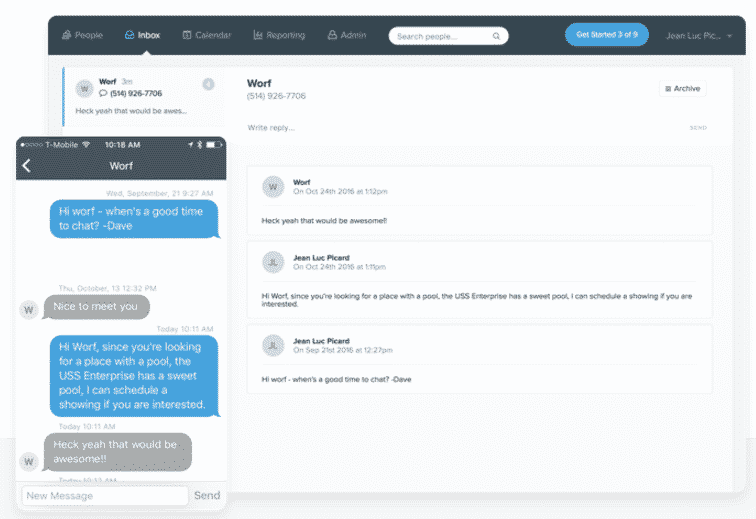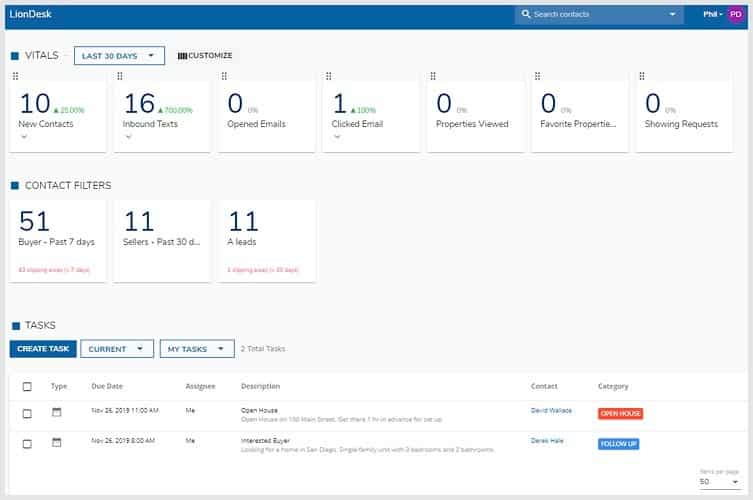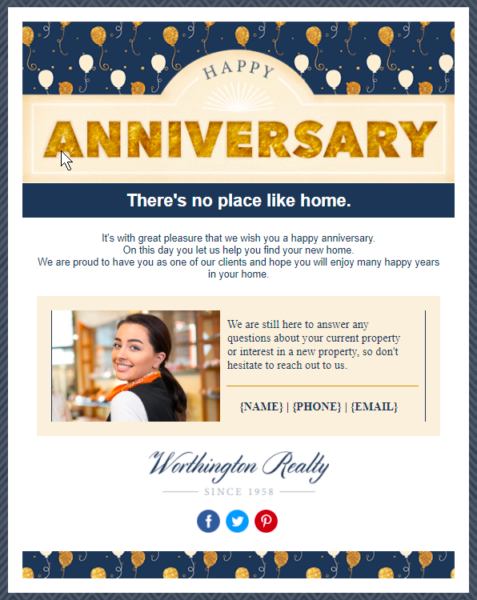Real estate drip campaigns deliver a sequence of automated emails or text messages to leads, allowing you to build and nurture a new connection. To implement an effective campaign, choose the right email marketing provider, customize your campaign for your audience, and test a variety of email frequencies, subject lines, and messages. With consistency, email campaigns can convert leads into loyal clients.
If you are ready to start nurturing your leads with realtor drip email campaigns, read the five steps you need to take before sending your first email and use the sequence templates (in Step 4 below) to plan your first campaign.
1. Choose an Email Marketing Provider to Send Your Campaigns
Since drip campaigns are fundamentally different from sending manual or individual emails, the first step is to choose the right real estate email marketing software. Email marketing tools help you organize contacts, create email lists, and typically have email templates ready to use. After choosing the right tool, you can start developing your realtor drip email campaigns and establish an email strategy.
Here are the four top real estate email marketing platforms:
Software | ||||
|---|---|---|---|---|
Best for | Agents and teams wanting in-depth email marketing functionality like segmentation, automation, and reporting | Professionals wanting a real estate-specific multichannel CRM with email, text, and phone dialers | Agents and teams wanting an all-in-one tool for generating and nurturing leads | Real estate professionals wanting a versatile and affordable tool that grows with their email list |
Key Features |
|
|
|
|
Starting Price | $12 per month | $39 per month | $299 per month | $0 |
Visit |
2. Create a Real Estate Drip Campaign Strategy
Just like each marketing method you use, it’s important to develop a complete strategy. Your realtor drip email campaigns should be planned according to your client’s individual journey. For instance, trying to push every lead to buy a house immediately would be ineffective because many of your leads may be home sellers or buyers who are planning for the future. Instead, you need to pay attention to your audience’s current needs and send emails that resonate with your leads at every stage of their individual journey.
Here are just a few factors to consider as you map out your real estate drip campaign:
Defining your audience is arguably one of the most essential elements of real estate marketing and lead generation. Some new real estate agents mistakenly think their audience is anyone and everyone, so they try to appeal to everyone. The result is overgeneralized marketing that is almost never effective.
Instead, the best drip campaigns for realtors are highly specific and created with a target audience or type of client in mind. By pinpointing your audience’s needs, struggles, fears, and goals, you’ll be able to create relevant emails that keep them engaged and draw them further into your market funnel. Separate the leads on your email list into categories like these:
- Buyers
- Sellers
- Warm leads
- Hot leads
- Cold leads
- Leads from specific sources (referrals, partners, online form, Zillow, etc.)
As you develop your campaigns and work more closely with each of your target audiences, continue to customize your content even more specifically. For example, you may find that it’s common for buyers in your area to need help differentiating between neighborhoods. You can then create content within an email outlining neighborhood features, local events, and popular establishments so buyers can choose the best fit. On the other hand, sellers typically need information pertaining to home upgrades or tasks they can do to maximize the value of their homes.
Since a real estate CRM drip campaign is scheduled in advance, finding the right timing is an important factor in your customers’ engagement. For example, even if you send incredibly valuable emails, it’s unlikely that home buyers and sellers will continue to stay engaged with emails once or twice a day. Carefully choose how often to send emails to each segment of your email list, and don’t be afraid to adjust timing and frequency until you figure out what works best.
Studies show that one-third of email marketers send emails every week, while only 13% send emails daily, monthly, or multiple times per week. These statistics differ between industries, but they suggest that most businesses see the best results from sending weekly emails.
When you’re learning what a drip campaign is in real estate, make sure you also understand how to appropriately use triggers. Trigger emails are automatically prompted when a subscriber takes a certain action. Some common triggers are for “events,” which refer to the readers clicking on a link in an email, filling out a form, or viewing a property. Leveraging triggers within your real estate email marketing strategy is a surefire way to ensure your email content is relevant and timed accurately.

Example of text drip campaign real estate (Source: Follow Up Boss)
There are many different types of triggers you can create within your email campaigns to make emails feel personal for each of your contacts. For example, mark down their birthdays, anniversaries, pet birthdays, and homebuying anniversaries and set a trigger email to celebrate every year. For potential buyers and sellers, set a trigger with a slightly different personalized check-in email once every month.

Sample dashboard to monitor contacts from LionDesk CRM (Source: LionDesk)
When you have the right CRM, it’s easy to identify your target audience and keep track of your real estate drip emails. For instance, LionDesk makes it easy to organize your existing contacts and automatically organizes new leads as they come in from a variety of sources. Along with its extensive third-party integrations and transaction management tools, LionDesk may be the key to creating profitable drip campaigns for real estate. Start your 30-day free trial today.
Pro tip: As you develop your email drip campaigns, consider infusing your strategy with text message marketing. Marketing text messages have a massive average open rate of 98%, making it easier for many customers to communicate through text instead of email. Combining email and text message drip campaigns can maximize communication and personalization with leads.
3. Strategically Design Your Drip Campaign Real Estate Emails
An important part of sending drip campaigns is keeping the repetitive nature of emails fresh and interesting. If you send the exact same type of email to your leads every time, like market reports or new listings, it can annoy your potential client and even get your account flagged as spam. Instead, send different types of emails throughout the buyer’s journey in order to best provide value and build trust.

Real estate email template (Source: Etsy)
That said, your emails should also keep some basic elements consistent. These are six elements of an effective email:
- Subject line: The subject line is the first thing a buyer sees in their inbox, and a weak subject line can prevent them from opening your email at all. Alternatively, a clear, strong subject line piques the interest of your leads by being relevant, unique, and interesting.
- Email body: The body of the email includes the majority of your content. Write interesting and unique information to give the reader a reason to continue reading and connecting with you.
- Email images: Images give your audience a visual representation of the information in the email. This is ideal for readers who are skimming content and want to get a sense of what the email is about. In particular, images are the best way to showcase the best features of real estate properties.
- Call to action (CTA): A CTA asks the reader to take some kind of action in order to move forward in the buying cycle, like clicking or subscribing. Strong CTAs are clear and actionable, often creating a sense of urgency for the reader.
- Social icons: Social icons allow readers to connect with agents on Facebook, Twitter, Instagram, and LinkedIn. While you can always send an email to an agent, social media gives them a way to engage with you on the platforms they are most comfortable with.
- Email signature: Almost every email platform will give you the ability to customize your signature and make sure it automatically appears with every email. It can be highly formatted to include your headshot and social media links, but even a simple signature with your name, title, phone number, and website address can be effective.
Pro tip: Don’t forget to include an “Unsubscribe” button in every email you send. It is legally required to allow your recipients to opt out of emails at any time by the CAN-SPAM laws. Even though having a contact unsubscribe from your list may feel like a failure, it actually ensures that your existing contacts are engaged and are leads who are likely to convert into clients.

Real estate email template (Source: Constant Contact)
Don’t assume that you have to create a new design with every new email in your campaign. Instead, work with a company like Constant Contact that already provides a selection of real estate email marketing templates. You can even save time by adding your branding to each template and using the simple drag-and-drop editor to customize the copy, images, and colors.
4. Create Your Drip Campaign Sequences
There are a wide variety of individual types of emails, like introductions, single listing emails, multiple listing emails, and open house announcements. However, drip campaigns are meant to be evergreen sequences that nurture new leads automatically. Although these campaigns may include information about properties in your area or past listings you’ve worked with, don’t include any highly time-sensitive information in your campaigns. This ensures that each email will feel current and personalized.
It’s best to start sending emails to your audience with the understanding that you will have to adjust many factors to get the best results. As you learn more details about your target audience, you can create triggers and alternative email campaigns to nurture your leads most effectively.
To help you get started, here are three examples of email drip campaign sequences for different types of audiences.
5. Schedule & Send Your Email Campaign
Once your emails are strategically written and designed for your audience, schedule your drip sequence for new and existing leads. Most platforms include an email scheduler. In fact, even Gmail allows you to schedule individual emails in advance.
However, you may want to choose an email tool that includes trigger marketing to further customize your user experience and maximize engagement. Not all email software provides this level of customization, but HubSpot offers comprehensive email scheduling, automation, and tracking to maximize the impact of your realtor drip email campaigns.

Trigger and behavioral marketing (Source: HubSpot)
HubSpot is one of the most popular and well-known marketing tools, partially because of its wide range of powerful and comprehensive tools. Within its Marketing Hub, you have access to tools that help you publish search engine optimized (SEO) blogs, manage social media platforms, integrate video with your contact, offer live chat support, track and manage contacts in a CRM, and of course, send highly customized real estate email drip campaigns. You can even start using HubSpot for free to see how the platform will elevate all of your marketing.
Real Estate Drip Campaign Statistics
Email campaigns are a powerful tool for realtors, but only truly effective when used correctly. Like all other real estate marketing strategies, you have to combine best practices with firsthand experience about what truly works for your audience. Staying up to date on the research about email marketing will help you make important decisions and more effectively nurture your email list.
Here are a few of the most important real estate email drip campaign statistics to keep in mind:
- Segmented email campaigns generate an average of 30% more opens and 50% more click-throughs than generalized campaigns
- The average email open rate was 34.5% across multiple industries, and the average click rate was 1.3%
- In the real estate industry in 2022, the average email open rate was 21.7%, and the average click-through rate was 3.6%
- Email is approximately 40 times more effective at generating new clients than Facebook and Twitter
- According to HubSpot, the three most effective strategies for email campaigns are segmenting (78%), personalization (72%), and automated campaigns (71%)
- Email campaigns with A/B testing and those tested for quality and spam receive a return up to 28% higher
Bottom Line
Real estate drip campaigns help you build a connection with leads through automated emails or text messages—essential for achieving success in the real estate industry. Drip campaigns are often spaced out by a few days and follow a logical pattern, and the right email software will help you test emails and customize your strategy.